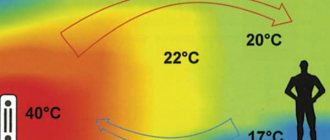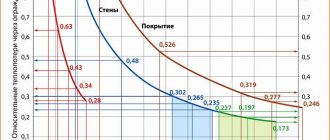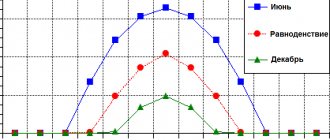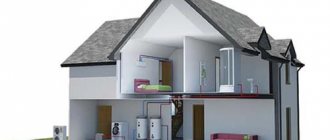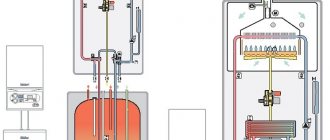Methods for determining load
First, let's explain the meaning of the term. Thermal load is the total amount of heat consumed by the heating system to heat the premises to the standard temperature in the coldest period. The value is calculated in energy units - kilowatts, kilocalories (less often - kilojoules) and is denoted in formulas by the Latin letter Q.
Knowing the heating load of a private house in general and the needs of each room in particular, it is not difficult to select a boiler, heaters and batteries of the water system according to power. How can you calculate this parameter:
- If the ceiling height does not reach 3 m, a larger calculation is made based on the area of heated rooms.
- For ceiling heights of 3 m or more, heat consumption is calculated based on the volume of the premises.
- Determination of heat loss through external fences and the cost of heating ventilation air in accordance with SNiP.
Note. In recent years, online calculators posted on the pages of various Internet resources have gained wide popularity. With their help, determining the amount of thermal energy is carried out quickly and does not require additional instructions. The downside is that the reliability of the results needs to be checked, because the programs are written by people who are not heating engineers.
Photo of the building taken with a thermal imager.
The first two calculation methods are based on the use of specific thermal characteristics in relation to the heated area or volume of the building. The algorithm is simple, used everywhere, but gives very approximate results and does not take into account the degree of insulation of the cottage.
Calculating thermal energy consumption according to SNiP, as design engineers do, is much more difficult. You will have to collect a lot of reference data and work hard on calculations, but the final numbers will reflect the real picture with 95% accuracy. We will try to simplify the methodology and make the calculation of the heating load as easy to understand as possible.
Types of thermal loads for calculations
When making calculations and choosing equipment, different thermal loads are taken into account:
- Seasonal loads
. having the following features:
- they are characterized by changes depending on the ambient temperature outside; — the presence of differences in the amount of thermal energy consumption in accordance with the climatic characteristics of the region where the house is located; — change in the load on the heating system depending on the time of day. Since external fences have heat resistance, this parameter is considered insignificant; — heat consumption of the ventilation system depending on the time of day.
Constant thermal loads
. In most heating and hot water supply systems they are used throughout the year. For example, in the warm season, thermal energy consumption is reduced by about 30-35% compared to the winter period.
Dry heat
. It represents thermal radiation and convection heat exchange due to other similar devices. This parameter is determined using the temperature of a dry thermometer. It depends on many factors, including windows and doors, ventilation systems, various equipment, and air exchange occurring due to the presence of cracks in the walls and ceilings. The number of people present in the room is also taken into account.
Latent heat
. Formed as a result of the process of evaporation and condensation. Temperature is determined using a wet thermometer. In any room for its intended purpose, the humidity level is affected by:
— the number of people simultaneously present in the room; — availability of technological or other equipment; - flows of air masses penetrating through cracks and cracks in the building envelope.
For example, a project for a one-story house of 100 m²
To clearly explain all the methods for determining the amount of thermal energy, we suggest taking as an example a one-story house with a total area of 100 square meters (according to external measurements), shown in the drawing. Let us list the technical characteristics of the building:
- region of construction – temperate climate zone (Minsk, Moscow);
- thickness of external fences – 38 cm, material – sand-lime brick;
- external wall insulation – foam plastic 100 mm thick, density – 25 kg/m³;
- floors – concrete on the ground, no basement;
- ceiling - reinforced concrete slabs, insulated on the cold attic side with 10 cm foam plastic;
- windows – standard metal-plastic with 2 glasses, size – 1500 x 1570 mm (h);
- the entrance door is metal 100 x 200 cm, insulated from the inside with 20 mm extruded polystyrene foam.
The cottage has half-brick (12 cm) interior partitions; the boiler room is located in a separate building. The areas of the rooms are indicated in the drawing, the height of the ceilings will be taken depending on the explained calculation method - 2.8 or 3 m.
Why is all this needed?
The problem should be considered from two points of view - from the point of view of apartment buildings and private ones. Let's start with the first ones.
Apartment buildings
There is nothing complicated here: gigacalories are used in thermal calculations. And if you know how much thermal energy remains in the house, then you can present the consumer with a specific bill. Let's give a small comparison: if centralized heating operates in the absence of a meter, then you have to pay according to the area of the heated room. If there is a heat meter, this in itself implies a horizontal wiring type (either collector or serial): two risers are brought into the apartment (for “return” and supply), and the intra-apartment system (more precisely, its configuration) is determined by the residents. This kind of scheme is used in new buildings, thanks to which people regulate the consumption of thermal energy, making a choice between savings and comfort.
Let's find out how this adjustment is carried out.
1. Installation of a general thermostat on the return line. In this case, the flow rate of the working fluid is determined by the temperature inside the apartment: if it decreases, the flow rate will accordingly increase, and if it increases, it will decrease.
2. Throttling of heating radiators. Thanks to the throttle, the passage of the heating device is limited, the temperature decreases, and therefore the consumption of thermal energy is reduced.
Private houses
We continue to talk about calculating Gcal for heating. Owners of country houses are interested, first of all, in the cost of a gigacalorie of thermal energy obtained from one or another type of fuel. The table below may help with this.
Table. Comparison of cost of 1 Gcal (including transport costs)
* - prices are approximate, since tariffs may differ depending on the region, moreover, they are constantly growing.
We calculate the heat consumption by quadrature
To roughly estimate the heating load, the simplest thermal calculation is usually used: take the outside area of the building and multiply it by 100 W. Accordingly, the heat consumption of a 100 m² country house will be 10,000 W or 10 kW. The result allows you to select a boiler with a safety factor of 1.2-1.3; in this case, the power of the unit is taken to be 12.5 kW.
We propose to perform more accurate calculations that take into account the location of rooms, the number of windows and the region of development. So, for ceiling heights up to 3 m, it is recommended to use the following formula:
The calculation is carried out for each room separately, then the results are summed up and multiplied by the regional coefficient. Explanation of formula symbols:
- Q – required load value, W;
- Spom – square footage of the room, m²;
- q – indicator of specific thermal characteristics, related to the area of the room, W/m²;
- k is a coefficient that takes into account the climate in the area of residence.
For reference. If a private house is located in a temperate climate zone, the coefficient k is taken equal to one. In the southern regions k = 0.7, in the northern regions values of 1.5–2 are used.
In an approximate calculation based on the total quadrature, the indicator q = 100 W/m². This approach does not take into account the location of the rooms and the different number of light openings. The corridor located inside the cottage will lose much less heat than a corner bedroom with windows of the same area. We propose to take the value of the specific thermal characteristic q as follows:
- for rooms with one external wall and a window (or door) q = 100 W/m²;
- corner rooms with one light opening - 120 W/m²;
- the same, with two windows – 130 W/m².
How to correctly select the value of q is clearly shown on the building plan. For our example, the calculation looks like this:
Q = (15.75 x 130 + 21 x 120 + 5 x 100 + 7 x 100 + 6 x 100 + 15.75 x 130 + 21 x 120) x 1 = 10935 W ≈ 11 kW.
As you can see, the refined calculations gave a different result - in fact, 1 kW more thermal energy will be consumed to heat a particular 100 m² house. The figure takes into account the heat consumption to heat the outside air entering the home through openings and walls (infiltration).
Calculation of heating standards in an apartment
In an apartment served by a utility company, the calculation of the heat load can only be carried out upon transfer of the house in order to track the SNIP parameters in the premises accepted for balance. Otherwise, the apartment owner does this in order to calculate his heat loss during the cold season and eliminate the shortcomings of insulation - use heat-insulating plaster, glue insulation, install penofol on the ceilings and install metal-plastic windows with a five-chamber profile.
Calculating heat leaks for a utility for the purpose of opening a dispute, as a rule, does not yield results. The reason is that there are heat loss standards. If the house is put into operation, then the requirements are met. At the same time, heating devices comply with the requirements of SNIP. Replacing batteries and extracting more heat is prohibited, since radiators are installed according to approved building standards.
Calculation of heat load by room volume
When the distance between the floors and the ceiling reaches 3 m or more, the previous calculation option cannot be used - the result will be incorrect. In such cases, the heating load is usually calculated according to specific aggregated indicators of heat consumption per 1 m³ of room volume.
The formula and calculation algorithm remain the same, only the area parameter S changes to volume – V:
Accordingly, another indicator of specific consumption q is adopted, related to the cubic capacity of each room:
- room inside the building or with one external wall and window – 35 W/m³;
- corner room with one window – 40 W/m³;
- the same, with two light openings - 45 W/m³.
Note. Increasing and decreasing regional coefficients k are applied in the formula without changes.
Now, as an example, let’s determine the heating load of our cottage, taking the ceiling height to be 3 m:
Q = (47.25 x 45 + 63 x 40 + 15 x 35 + 21 x 35 + 18 x 35 + 47.25 x 45 + 63 x 40) x 1 = 11182 W ≈ 11.2 kW.
It is noticeable that the required thermal power of the heating system has increased by 200 W compared to the previous calculation. If we take the height of the rooms to be 2.7-2.8 m and calculate the energy costs per cubic capacity, then the figures will be approximately the same. That is, the method is quite applicable for an aggregated calculation of heat loss in rooms of any height.
Simple area calculations
You can calculate the size of heating batteries for a specific room based on its area. This is the easiest way - to use plumbing standards, which stipulate that a thermal power of 100 W per hour is needed to heat 1 sq.m. We must remember that this method is used for rooms with standard ceiling heights (2.5-2.7 meters), and the result is somewhat inflated. In addition, it does not take into account such features as:
- number of windows and type of double-glazed windows on them;
- the number of external walls in the room;
- the thickness of the building walls and what material they are made of;
- type and thickness of insulation used;
- temperature range in a given climate zone.
The heat that radiators must provide to heat the room: the area should be multiplied by the thermal power (100 W). For example, for a room of 18 sq.m the following power of the heating battery is required:
18 sq.m x 100 W = 1800 W
That is, 1.8 kW of power is needed per hour to heat 18 square meters. This result must be divided by the amount of heat that the heating radiator section produces per hour. If the data in his passport indicates that this is 170 W, then the next stage of the calculation looks like this:
1800 W / 170 W = 10.59
This number must be rounded to the nearest whole number (usually rounded up) - it will be 11. That is, in order for the temperature in the room to be optimal during the heating season, it is necessary to install a heating radiator with 11 sections.
This method is only suitable for calculating the battery size in rooms with central heating, where the coolant temperature is not higher than 70 degrees Celsius.
There is a simpler method that can be used for normal apartment conditions in panel houses. This approximate calculation takes into account that one section is needed to heat 1.8 square meters of area. In other words, the area of the room must be divided by 1.8. For example, with an area of 25 sq.m., 14 parts are needed:
25 sq.m / 1.8 sq.m = 13.89
But this calculation method is unacceptable for a radiator of reduced or increased power (when the average output of one section varies from 120 to 200 W).
How to use the results of calculations
Knowing the building's thermal energy needs, the homeowner can:
- clearly select the power of thermal power equipment for heating the cottage;
- dial the required number of radiator sections;
- determine the required thickness of insulation and perform thermal insulation of the building;
- find out the coolant flow in any part of the system and, if necessary, perform a hydraulic calculation of the pipelines;
- find out the average daily and monthly heat consumption.
The last point is of particular interest. We found the value of the heat load for 1 hour, but it can be recalculated for a longer period and calculate the expected fuel consumption - gas, wood or pellets.
How to calculate the load?
The heat load indicator is determined by several of the most important factors, therefore, when performing design measures, it is imperative to take into account:
- total glazing area and number of doors;
- difference in temperature conditions outside and inside the building;
- performance level, operating mode of the ventilation system;
- thickness of structures and materials involved in the construction of the structure;
- properties of roofing material and main design features of the roof;
- the amount of insolation and the degree of absorption of solar heat by external surfaces.
It is practiced to use several methods for calculating the thermal load, which differ markedly not only in the degree of complexity, but also in the accuracy of the calculated results. It is important to first collect the information necessary for design and calculation activities regarding the installation diagram of radiators and the location of the hot water supply, as well as the floor plan and explication of the structure.
Calculation of heating system power based on housing area
One of the fastest and easiest to understand ways to determine the power of a heating system is to calculate the area of the room. This method is widely used by sellers of heating boilers and radiators. Calculating the power of a heating system by area occurs in a few simple steps.
Step 1.
Based on the plan or already erected building, the internal area of the building in square meters is determined.
Step 2.
The resulting figure is multiplied by 100-150 - this is exactly how many watts of the total power of the heating system are needed for each m 2 of housing.
Step 3.
Then the result is multiplied by 1.2 or 1.25 - this is necessary to create a power reserve so that the heating system is able to maintain a comfortable temperature in the house even in the event of the most severe frosts.
Step 4.
The final figure is calculated and recorded - the power of the heating system in watts required to heat a particular home. As an example, to maintain a comfortable temperature in a private house with an area of 120 m2, approximately 15,000 W will be required.
Step 5.
Based on the already determined calculation data, a specific model of the heating boiler and radiators is selected.
Independent calculation of thermal power
The preparation of a heating project for both residential country houses and industrial complexes begins with a thermal engineering calculation. A heat gun is assumed to be the heat source.
What is a thermal engineering calculation?
Calculation of heat losses is a fundamental document designed to solve such a problem as organizing the heat supply of a structure. It determines daily and annual heat consumption, the minimum heat energy requirement of a residential or industrial facility and heat losses for each room. When solving a problem such as thermal engineering calculations, one should take into account a set of characteristics of the object:
- Type of object (private house, one-story or multi-story building, administrative, industrial or warehouse).
- The number of people living in the building or working in one shift, the number of hot water supply points.
- Architectural part (dimensions of the roof, walls, floors, dimensions of door and window openings).
- Special data, for example, the number of working days per year (for production), the duration of the heating season (for objects of any type).
- Temperature conditions in each of the premises of the facility (they are determined by CHiP 2.04.05-91).
- Functional purpose (warehouse production, residential, administrative or household).
- Structures of the roof, external walls, floors (type of insulating layers and materials used, thickness of floors).
Why do you need a thermal engineering calculation?
- To determine the boiler power. Let's assume you have decided to equip your country house or business with an autonomous heating system. To decide on the choice of equipment, you will first need to calculate the power of the heating installation, which will be needed for the uninterrupted operation of hot water supply, air conditioning, ventilation systems, as well as efficient heating of the building. The power of an autonomous heating system is determined as the total amount of heat costs for heating all rooms, as well as heat costs for other technological needs. The heating system must have a certain power reserve so that operation at peak loads does not shorten its service life.
- To complete approval for gasification of the facility and obtain technical specifications. It is necessary to obtain permission to gasify the facility if natural gas is used as fuel for the boiler. To obtain specifications, you will need to provide the values of annual fuel consumption (natural gas), as well as the total values of the power of thermal sources (Gcal/hour). These indicators are determined as a result of thermal calculations. Approval of a project for the gasification of a facility is a more expensive and time-consuming method of organizing autonomous heating compared to the installation of heating systems operating on waste oils, the installation of which does not require approvals and permits.
- To select suitable equipment. Thermal calculation data is the determining factor when choosing devices for heating objects. Many parameters should be taken into account - orientation to the cardinal directions, dimensions of door and window openings, dimensions of rooms and their location in the building.
How does thermal engineering calculation work?
You can use a simplified formula to determine the minimum permissible power of thermal systems:
Qt (kW/hour) =V * ΔT * K /860, where
Qt is the heat load on a certain room; K – heat loss coefficient of the building; V – volume (in m3) of the heated room (width of the room by length and height); ΔT is the difference (indicated by C) between the required air temperature inside and outside temperature.
An indicator such as heat loss coefficient (K) depends on the insulation and type of construction of the room. You can use simplified values calculated for objects of different types:
- K = from 0.6 to 0.9 (increased degree of thermal insulation). A small number of windows equipped with double frames, brick walls with double thermal insulation, a roof made of high quality material, a solid floor base;
- K = from 1 to 1.9 (medium thermal insulation). Double brickwork, plain roof, few windows;
- K = from 2 to 2.9 (low thermal insulation). The structure of the building is simplified, single brickwork.
- K = 3 – 4 (no thermal insulation). A structure made of metal or corrugated sheets or a simplified wooden structure.
When determining the difference between the required temperature inside the heated volume and the temperature outside (ΔT), you should proceed from the degree of comfort that you want to receive from the heating installation, as well as from the climatic characteristics of the region in which the object is located. The default parameters are the values defined by CHiP 2.04.05-91:
- +18 – public buildings and production workshops;
- +12 – high-rise storage complexes, warehouses;
- + 5 – garages and warehouses without constant maintenance.
| City | Estimated outside temperature, °C | City | Estimated outside temperature, °C |
| Dnepropetrovsk | — 25 | Kaunas | — 22 |
| Ekaterinburg | — 35 | Lviv | — 19 |
| Zaporozhye | — 22 | Moscow | — 28 |
| Kaliningrad | — 18 | Minsk | — 25 |
| Krasnodar | — 19 | Novorossiysk | — 13 |
| Kazan | — 32 | Nizhny Novgorod | — 30 |
| Kyiv | — 22 | Odessa | — 18 |
| Rostov | — 22 | Saint Petersburg | — 26 |
| Samara | — 30 | Sevastopol | — 11 |
| Kharkiv | — 23 | Yalta | — 6 |
Calculation using a simplified formula does not allow taking into account differences in heat losses of a building depending on the type of enclosing structures, insulation and placement of premises. For example, rooms with large windows, high ceilings and corner rooms will require more heat. At the same time, rooms that do not have external fences have minimal heat losses. It is advisable to use the following formula when calculating such a parameter as minimum thermal power :
Qt (kW/hour)=(100 W/m2 * S (m2) * K1 * K2 * K3 * K4 * K5 * K6 * K7)/1000, where
S – room area, m2; W/m2 – specific value of heat loss (65-80 watt/m2). This indicator includes heat loss through ventilation, absorption by walls, windows and other types of leaks; K1 – coefficient of heat leakage through windows:
- if there is a triple glazed window K1 = 0.85;
- if the double-glazed window is double-glazed, then K1 = 1.0;
- with standard glazing K1 = 1.27;
K2 – wall heat loss coefficient:
- high thermal insulation (K2 index = 0.854);
- 150 mm thick insulation or two-brick walls (K2 index = 1.0);
- low thermal insulation (K2 indicator = 1.27);
K3 is an indicator that determines the ratio of the areas (S) of windows and floors:
- 50% short circuit = 1.2;
- 40% short circuit = 1.1;
- 30% short circuit = 1.0;
- 20% CV=0.9;
- 10% SC=0.8;
K4 – outdoor temperature coefficient:
- -35°C K4=1.5;
- -25°C K4=1.3;
- -20°C K4=1.1;
- -15°C K4=0.9;
- -10°C K4=0.7;
K5 – number of walls facing outwards:
- four walls K5=1.4;
- three walls K5=1.3;
- two walls K5=1.2;
- one wall K5=1.1;
K6 - type of thermal insulation of the room, which is located above the heated room:
- heated K6-0.8;
- warm attic K6=0.9;
- unheated attic K6=1.0;
K7 – ceiling height:
- 4.5 meters K7=1.2;
- 4.0 meters K7=1.15;
- 3.5 meters K7=1.1;
- 3.0 meters K7=1.05;
- 2.5 meters K7=1.0.
Let us give as an example the calculation of the minimum power of an autonomous heating installation (using two formulas) for a separate service station room (ceiling height 4 m, area 250 m2, volume 1000 m3, large windows with conventional glazing, no thermal insulation of the ceiling and walls, simplified design) .
According to a simplified calculation:
Qt (kW/hour) = V * ΔT * K/860=1000 *30*4/860=139.53 kW, where
V is the volume of air in the heated room (250 *4), m3; ΔT is the difference between the air temperature outside the room and the required air temperature inside the room (30°C); K is the heat loss coefficient of the building (for buildings without thermal insulation K = 4.0); 860 - conversion to kW/hour.
More accurate calculation:
Qt (kW/hour) = (100 W/m2 * S (m2) * K1 * K2 * K3 * K4 * K5 * K6 * K7)/1000 = 100*250*1.27*1.27*1.1 *1.5*1.4*1*1.15/1000=107.12 kW/hour, where
S – area of the room for which the calculation is performed (250 m2); K1 – parameter of heat leakage through windows (standard glazing, K1 index is 1.27); K2 – the value of heat leakage through the walls (poor thermal insulation, the K2 indicator corresponds to 1.27); K3 – parameter of the ratio of window dimensions to floor area (40%, K3 indicator is 1.1); K4 – outside temperature value (-35 °C, K4 indicator corresponds to 1.5); K5 – the number of walls that go outside (in this case, four K5 is equal to 1.4); K6 - an indicator that determines the type of room located directly above the heated room (attic without insulation K6 = 1.0); K7 is an indicator that determines the height of the ceilings (4.0 m, parameter K7 corresponds to 1.15).
As you can see from the calculation, the second formula is preferable for calculating the power of heating installations, since it takes into account a much larger number of parameters (especially if it is necessary to determine the parameters of low-power equipment intended for use in small rooms). To the obtained result it is necessary to add a small power reserve to increase the service life of thermal equipment. By performing simple calculations, you can, without the help of specialists, determine the required power of an autonomous heating system to equip residential or industrial facilities.
You can buy a heat gun and other heaters on the company’s website or by visiting our retail store.
Thermal engineering calculation of an individual residential building
The above methods of aggregated calculations are most focused on sellers or buyers of radiators for heating systems installed in typical multi-story residential buildings. But when it comes to selecting expensive boiler equipment, or planning a heating system for a country house, in which, in addition to radiators, underfloor heating, hot water supply and ventilation systems will be installed, using these methods is highly not recommended.
Each owner of an individual residential building or cottage, even at the construction stage, is quite scrupulous in developing construction documentation, which takes into account all modern trends in the use of building materials and house structures. They must not be standard or obsolete, but made using modern energy-efficient technologies. Consequently, the thermal power of the heating system should be proportionally lower, and the total costs of installing a home heating system are much cheaper. These measures make it possible to reduce energy consumption costs in the future when using heating equipment.
Heat loss calculations are performed in specialized programs or using basic formulas and thermal conductivity coefficients of structures; the influence of air infiltration and the presence or absence of ventilation systems in the building are taken into account. Calculation of recessed basement rooms, as well as outer floors, is carried out using a method different from the main calculations, which takes into account the uneven cooling of horizontal structures, that is, heat loss through the roof and floor. The above methods do not take this indicator into account.
Thermal engineering calculations are carried out, as a rule, by qualified specialists as part of a heating system project, as a result of which further calculations are made of the number and power of heating devices, the power of individual equipment, the selection of pumps and other related equipment.
As an illustrative example, let us calculate heat loss in a specialized program for three houses built using the same technology, but with different thicknesses of thermal insulation of external walls: 100 mm, 150 mm and 200 mm. The calculation is carried out for a corner living room with one window, with an area of 8.12 m². Construction region Moscow region.
Initial data:
- A room with external dimensions of 3000x3000;
- Window dimensions 1200x1000.
The purpose of the calculation is to determine the specific power of the heating system required to heat 1 m².
Result:
- Qsp at 100 mm insulation is 103 W/m?
- Qsp at 150 mm insulation is 81 W/m?
- Qsp at 200 mm insulation is 70 W/m?
As can be seen from the calculation, the greatest heat losses are for a residential building with the smallest insulation thickness, therefore, the power of boiler equipment and radiators will be 47% higher than when building a house with 200 mm thermal insulation.
Why is thermal calculation necessary?
Some owners of private houses or those who are just planning to build them are interested in whether there is any point in the thermal calculation of the heating system? After all, we are talking about a simple country cottage, and not about an apartment building or an industrial enterprise. It would seem that it would be enough just to buy a boiler, install radiators and run pipes to them. On the one hand, they are partially right - for private households, the calculation of the heating system is not as critical an issue as for industrial premises or multi-apartment residential complexes. On the other hand, there are three reasons why such an event is worth holding. , you can read in our article.
- Thermal calculation significantly simplifies the bureaucratic processes associated with gasification of a private home.
- Determining the power required for heating a home allows you to select a heating boiler with optimal characteristics. You will not overpay for excessive product characteristics and will not experience inconvenience due to the fact that the boiler is not powerful enough for your home.
- Thermal calculation allows you to more accurately select pipes, shut-off valves and other equipment for the heating system of a private home. And in the end, all these rather expensive products will work for as long as is included in their design and characteristics.

